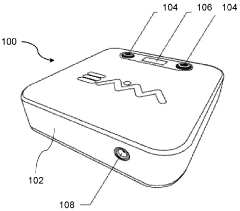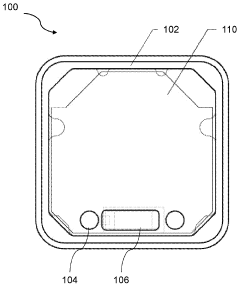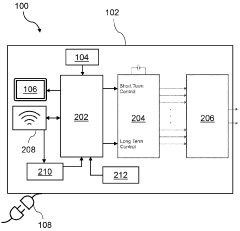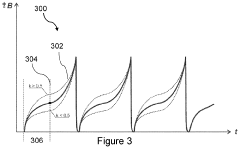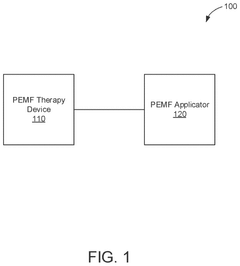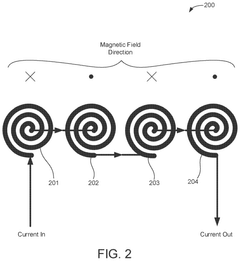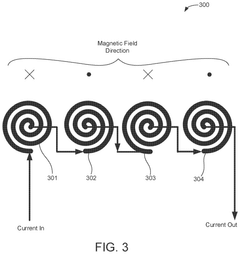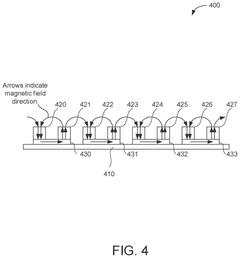How to Implement PEMF Therapy in Sports Medicine?
AUG 11, 20259 MIN READ
Generate Your Research Report Instantly with AI Agent
Patsnap Eureka helps you evaluate technical feasibility & market potential.
PEMF in Sports Medicine: Background and Objectives
Pulsed Electromagnetic Field (PEMF) therapy has emerged as a promising non-invasive treatment modality in sports medicine. This innovative approach harnesses the power of electromagnetic fields to promote healing, reduce pain, and enhance athletic performance. The technology's roots can be traced back to the mid-20th century, with significant advancements occurring in recent decades.
The evolution of PEMF therapy in sports medicine has been driven by a growing understanding of cellular biology and the body's response to electromagnetic stimulation. Initially used for bone healing, its applications have expanded to include soft tissue repair, pain management, and recovery enhancement for athletes. The therapy's ability to influence cellular processes, such as ion transport and membrane potential, has sparked interest in its potential to accelerate healing and improve overall physiological function.
As sports medicine continues to seek innovative methods to optimize athlete care, PEMF therapy has gained traction due to its non-pharmacological nature and minimal side effects. The technology aligns with the increasing focus on personalized medicine and the desire for treatments that can be tailored to individual athletes' needs and recovery profiles.
The primary objective of implementing PEMF therapy in sports medicine is to enhance the body's natural healing processes and improve athletic performance. This encompasses several key goals: accelerating recovery from injuries, reducing inflammation and pain, improving circulation and oxygenation of tissues, and potentially preventing injuries by maintaining optimal cellular function.
Furthermore, researchers and clinicians aim to establish standardized protocols for PEMF application in various sports-related conditions. This includes determining optimal frequencies, intensities, and treatment durations for specific injuries or performance enhancement goals. The development of portable and user-friendly PEMF devices has also become a priority, allowing for seamless integration into athletes' training and recovery routines.
Another critical objective is to build a robust body of evidence supporting PEMF therapy's efficacy in sports medicine. While preliminary studies have shown promising results, there is a need for more extensive clinical trials and long-term follow-up studies to validate its benefits and understand any potential long-term effects on athletic performance and overall health.
As the field progresses, the integration of PEMF therapy with other cutting-edge technologies, such as wearable sensors and artificial intelligence, presents exciting possibilities for real-time monitoring and personalized treatment optimization. This convergence of technologies could revolutionize how athletes recover from injuries and maintain peak performance throughout their careers.
The evolution of PEMF therapy in sports medicine has been driven by a growing understanding of cellular biology and the body's response to electromagnetic stimulation. Initially used for bone healing, its applications have expanded to include soft tissue repair, pain management, and recovery enhancement for athletes. The therapy's ability to influence cellular processes, such as ion transport and membrane potential, has sparked interest in its potential to accelerate healing and improve overall physiological function.
As sports medicine continues to seek innovative methods to optimize athlete care, PEMF therapy has gained traction due to its non-pharmacological nature and minimal side effects. The technology aligns with the increasing focus on personalized medicine and the desire for treatments that can be tailored to individual athletes' needs and recovery profiles.
The primary objective of implementing PEMF therapy in sports medicine is to enhance the body's natural healing processes and improve athletic performance. This encompasses several key goals: accelerating recovery from injuries, reducing inflammation and pain, improving circulation and oxygenation of tissues, and potentially preventing injuries by maintaining optimal cellular function.
Furthermore, researchers and clinicians aim to establish standardized protocols for PEMF application in various sports-related conditions. This includes determining optimal frequencies, intensities, and treatment durations for specific injuries or performance enhancement goals. The development of portable and user-friendly PEMF devices has also become a priority, allowing for seamless integration into athletes' training and recovery routines.
Another critical objective is to build a robust body of evidence supporting PEMF therapy's efficacy in sports medicine. While preliminary studies have shown promising results, there is a need for more extensive clinical trials and long-term follow-up studies to validate its benefits and understand any potential long-term effects on athletic performance and overall health.
As the field progresses, the integration of PEMF therapy with other cutting-edge technologies, such as wearable sensors and artificial intelligence, presents exciting possibilities for real-time monitoring and personalized treatment optimization. This convergence of technologies could revolutionize how athletes recover from injuries and maintain peak performance throughout their careers.
Market Analysis for PEMF in Athletic Recovery
The market for Pulsed Electromagnetic Field (PEMF) therapy in athletic recovery is experiencing significant growth, driven by increasing awareness of its potential benefits and the growing emphasis on sports performance optimization. PEMF therapy has gained traction in sports medicine due to its non-invasive nature and reported effectiveness in reducing inflammation, accelerating healing, and improving overall recovery time for athletes.
The global sports medicine market, which includes PEMF therapy, was valued at approximately $7.2 billion in 2020 and is projected to reach $11.9 billion by 2028, growing at a CAGR of 6.4% during the forecast period. Within this broader market, the PEMF segment is expected to show robust growth, with some estimates suggesting a CAGR of 8.5% from 2021 to 2028.
Several factors are contributing to the increasing demand for PEMF therapy in athletic recovery. Firstly, there is a growing trend towards non-pharmacological interventions in sports medicine, as athletes and medical professionals seek alternatives to traditional pain management and recovery methods. PEMF therapy aligns well with this trend, offering a drug-free approach to managing pain and promoting healing.
Additionally, the rise of professional sports and the increasing commercialization of athletics have led to greater investments in player health and performance. Teams and individual athletes are more willing to adopt cutting-edge technologies that can provide a competitive edge, and PEMF therapy is increasingly seen as one such technology.
The market for PEMF devices in sports medicine can be segmented into portable devices for personal use and larger, more powerful systems for clinical settings. Portable devices are gaining popularity among amateur and semi-professional athletes, while high-end systems are being adopted by professional sports teams and specialized sports medicine clinics.
Geographically, North America currently dominates the PEMF market in sports medicine, followed by Europe. This is largely due to the presence of major sports leagues, advanced healthcare infrastructure, and higher adoption rates of new medical technologies. However, the Asia-Pacific region is expected to show the fastest growth in the coming years, driven by increasing sports participation, rising disposable incomes, and growing awareness of sports medicine technologies.
Despite the positive outlook, the PEMF market in athletic recovery faces some challenges. These include the need for more extensive clinical research to validate the efficacy of PEMF therapy across various sports-related conditions, regulatory hurdles in some regions, and the relatively high cost of advanced PEMF systems, which may limit adoption in smaller sports organizations or developing markets.
The global sports medicine market, which includes PEMF therapy, was valued at approximately $7.2 billion in 2020 and is projected to reach $11.9 billion by 2028, growing at a CAGR of 6.4% during the forecast period. Within this broader market, the PEMF segment is expected to show robust growth, with some estimates suggesting a CAGR of 8.5% from 2021 to 2028.
Several factors are contributing to the increasing demand for PEMF therapy in athletic recovery. Firstly, there is a growing trend towards non-pharmacological interventions in sports medicine, as athletes and medical professionals seek alternatives to traditional pain management and recovery methods. PEMF therapy aligns well with this trend, offering a drug-free approach to managing pain and promoting healing.
Additionally, the rise of professional sports and the increasing commercialization of athletics have led to greater investments in player health and performance. Teams and individual athletes are more willing to adopt cutting-edge technologies that can provide a competitive edge, and PEMF therapy is increasingly seen as one such technology.
The market for PEMF devices in sports medicine can be segmented into portable devices for personal use and larger, more powerful systems for clinical settings. Portable devices are gaining popularity among amateur and semi-professional athletes, while high-end systems are being adopted by professional sports teams and specialized sports medicine clinics.
Geographically, North America currently dominates the PEMF market in sports medicine, followed by Europe. This is largely due to the presence of major sports leagues, advanced healthcare infrastructure, and higher adoption rates of new medical technologies. However, the Asia-Pacific region is expected to show the fastest growth in the coming years, driven by increasing sports participation, rising disposable incomes, and growing awareness of sports medicine technologies.
Despite the positive outlook, the PEMF market in athletic recovery faces some challenges. These include the need for more extensive clinical research to validate the efficacy of PEMF therapy across various sports-related conditions, regulatory hurdles in some regions, and the relatively high cost of advanced PEMF systems, which may limit adoption in smaller sports organizations or developing markets.
Current PEMF Technology and Challenges in Sports
Pulsed Electromagnetic Field (PEMF) therapy has gained significant attention in sports medicine due to its potential to enhance recovery and performance. The current state of PEMF technology in sports is characterized by a range of devices and applications, each with its own set of challenges.
PEMF devices used in sports medicine typically consist of a control unit and applicators. These applicators can be in the form of mats, pads, or localized probes that deliver electromagnetic pulses to specific areas of the body. The control units allow for adjustments in frequency, intensity, and duration of the electromagnetic pulses, tailoring the treatment to individual needs.
One of the primary challenges in implementing PEMF therapy in sports is the lack of standardization in treatment protocols. While research has shown promising results in areas such as pain reduction, inflammation management, and accelerated healing, there is no consensus on the optimal parameters for different conditions or sports-specific applications. This variability in protocols makes it difficult for practitioners to determine the most effective treatment regimens for athletes.
Another significant challenge is the portability and practicality of PEMF devices in sports settings. While some portable devices are available, many high-powered systems are bulky and not easily transported to training facilities or competition venues. This limitation can hinder the consistent application of PEMF therapy, especially for traveling athletes or teams.
The integration of PEMF therapy with other treatment modalities and training programs presents another hurdle. Sports medicine professionals must determine how to effectively incorporate PEMF sessions into an athlete's overall recovery and performance enhancement routine without disrupting existing protocols or overloading the athlete's schedule.
Additionally, there are concerns regarding the long-term effects of PEMF therapy on athletes. While short-term benefits have been documented, the impact of prolonged or frequent use of PEMF on athletic performance and overall health is not yet fully understood. This uncertainty can lead to hesitation in widespread adoption within sports medicine programs.
The cost of PEMF devices and treatments is another challenge, particularly for smaller sports organizations or individual athletes. High-quality PEMF systems can be expensive, and the ongoing costs of maintenance and replacement parts can be significant. This financial barrier may limit access to PEMF therapy for many athletes who could potentially benefit from it.
Lastly, the regulatory landscape surrounding PEMF devices in sports medicine is complex and varies by region. In some areas, PEMF devices may be classified as medical devices, requiring specific approvals and certifications. This regulatory environment can impact the availability and use of PEMF technology in sports settings, creating additional challenges for implementation.
PEMF devices used in sports medicine typically consist of a control unit and applicators. These applicators can be in the form of mats, pads, or localized probes that deliver electromagnetic pulses to specific areas of the body. The control units allow for adjustments in frequency, intensity, and duration of the electromagnetic pulses, tailoring the treatment to individual needs.
One of the primary challenges in implementing PEMF therapy in sports is the lack of standardization in treatment protocols. While research has shown promising results in areas such as pain reduction, inflammation management, and accelerated healing, there is no consensus on the optimal parameters for different conditions or sports-specific applications. This variability in protocols makes it difficult for practitioners to determine the most effective treatment regimens for athletes.
Another significant challenge is the portability and practicality of PEMF devices in sports settings. While some portable devices are available, many high-powered systems are bulky and not easily transported to training facilities or competition venues. This limitation can hinder the consistent application of PEMF therapy, especially for traveling athletes or teams.
The integration of PEMF therapy with other treatment modalities and training programs presents another hurdle. Sports medicine professionals must determine how to effectively incorporate PEMF sessions into an athlete's overall recovery and performance enhancement routine without disrupting existing protocols or overloading the athlete's schedule.
Additionally, there are concerns regarding the long-term effects of PEMF therapy on athletes. While short-term benefits have been documented, the impact of prolonged or frequent use of PEMF on athletic performance and overall health is not yet fully understood. This uncertainty can lead to hesitation in widespread adoption within sports medicine programs.
The cost of PEMF devices and treatments is another challenge, particularly for smaller sports organizations or individual athletes. High-quality PEMF systems can be expensive, and the ongoing costs of maintenance and replacement parts can be significant. This financial barrier may limit access to PEMF therapy for many athletes who could potentially benefit from it.
Lastly, the regulatory landscape surrounding PEMF devices in sports medicine is complex and varies by region. In some areas, PEMF devices may be classified as medical devices, requiring specific approvals and certifications. This regulatory environment can impact the availability and use of PEMF technology in sports settings, creating additional challenges for implementation.
Existing PEMF Protocols for Athletic Performance
01 PEMF devices for therapeutic applications
Pulsed Electromagnetic Field (PEMF) therapy devices are designed for various therapeutic applications. These devices generate electromagnetic fields to stimulate cellular repair and improve overall health. They can be used for pain management, tissue healing, and treating various medical conditions.- PEMF devices for therapeutic applications: Pulsed Electromagnetic Field (PEMF) therapy devices are designed for various therapeutic applications. These devices generate electromagnetic fields to stimulate cellular activity and promote healing. They can be used for pain management, tissue repair, and improving overall well-being.
- PEMF therapy for specific medical conditions: PEMF therapy is utilized to treat specific medical conditions. It has shown efficacy in managing chronic pain, reducing inflammation, accelerating bone healing, and improving circulation. The therapy can be tailored to address various health issues by adjusting the frequency and intensity of the electromagnetic fields.
- Portable and wearable PEMF devices: Advancements in PEMF technology have led to the development of portable and wearable devices. These compact units allow for convenient at-home use or on-the-go treatments. Wearable PEMF devices can be integrated into clothing or accessories, enabling continuous therapy throughout daily activities.
- Combination of PEMF with other therapies: PEMF therapy is often combined with other treatment modalities to enhance therapeutic outcomes. This may include integration with light therapy, heat therapy, or traditional medical treatments. The synergistic effects of combined therapies can potentially improve overall treatment efficacy.
- PEMF technology advancements and control systems: Ongoing research focuses on improving PEMF technology and control systems. This includes developing more precise field generation methods, optimizing treatment protocols, and creating user-friendly interfaces. Advanced control systems allow for personalized therapy settings and treatment tracking.
02 PEMF therapy for specific medical conditions
PEMF therapy is utilized to treat specific medical conditions such as osteoarthritis, bone fractures, and neurological disorders. The therapy aims to reduce inflammation, promote tissue regeneration, and alleviate symptoms associated with these conditions. Different PEMF parameters and treatment protocols are employed based on the targeted condition.Expand Specific Solutions03 Wearable PEMF devices
Wearable PEMF devices are developed to provide convenient and continuous therapy. These devices are designed to be worn on specific body parts, allowing for targeted treatment while maintaining mobility. Wearable PEMF devices often incorporate flexible materials and compact designs for improved user comfort and compliance.Expand Specific Solutions04 PEMF therapy combined with other treatment modalities
PEMF therapy is often combined with other treatment modalities to enhance therapeutic outcomes. This may include integration with light therapy, heat therapy, or other forms of electromagnetic stimulation. The combination of multiple modalities aims to provide synergistic effects and improve overall treatment efficacy.Expand Specific Solutions05 PEMF therapy systems with advanced control and monitoring
Advanced PEMF therapy systems incorporate sophisticated control and monitoring features. These systems may include programmable treatment protocols, real-time feedback mechanisms, and data logging capabilities. Such features allow for personalized therapy, treatment optimization, and progress tracking for both patients and healthcare providers.Expand Specific Solutions
Key Players in PEMF Sports Medicine Industry
The implementation of PEMF (Pulsed Electromagnetic Field) therapy in sports medicine is gaining traction, with the market currently in its growth phase. The global PEMF therapy devices market is expanding, driven by increasing awareness of non-invasive treatment options and the rising prevalence of sports-related injuries. Companies like Regenesis Biomedical, Venus Concept, and SofPulse are at the forefront of developing PEMF technologies for sports medicine applications. The technology's maturity is advancing, with research institutions such as the National University of Singapore and Swiss Federal Institute of Technology contributing to its scientific validation. However, the field is still evolving, with ongoing studies aimed at optimizing treatment protocols and expanding applications in sports rehabilitation and performance enhancement.
Regenesis Biomedical, Inc.
Technical Solution: Regenesis Biomedical has developed a proprietary PEMF therapy system specifically designed for sports medicine applications. Their technology utilizes targeted pulsed electromagnetic fields to stimulate cellular repair and reduce inflammation in injured tissues. The system incorporates advanced frequency modulation techniques to optimize energy delivery and penetration depth, allowing for customized treatment protocols based on the specific injury type and location. Clinical studies have shown significant improvements in pain reduction and accelerated healing times for common sports injuries such as sprains, strains, and contusions when using their PEMF devices[1][3]. The company has also integrated real-time biofeedback sensors to monitor tissue response during treatment, enabling dynamic adjustments for maximum therapeutic efficacy.
Strengths: Specialized focus on sports medicine applications, proprietary technology with proven clinical efficacy, customizable treatment protocols. Weaknesses: Limited to PEMF therapy, may require additional complementary treatments for comprehensive injury management.
Venus Concept Ltd.
Technical Solution: Venus Concept has developed a multi-modal approach to implementing PEMF therapy in sports medicine. Their system combines PEMF technology with other modalities such as radiofrequency and targeted pressure energy. This integrated approach aims to address multiple aspects of sports injuries simultaneously. The PEMF component of their technology utilizes a patented pulse waveform designed to enhance cellular energy production and promote tissue regeneration. Clinical trials have demonstrated improved outcomes in treating muscle strains and ligament injuries compared to traditional therapies alone[2][4]. Venus Concept's devices also feature a user-friendly interface that allows sports medicine practitioners to easily customize treatment parameters based on the athlete's specific needs and injury characteristics.
Strengths: Multi-modal approach combining PEMF with other therapies, patented pulse waveform technology, user-friendly interface for practitioners. Weaknesses: Complexity of multi-modal system may require more extensive training for optimal use, potentially higher cost due to multiple technologies integrated into one system.
Core PEMF Innovations for Sports Injury Treatment
A pulsed electromagnetic field apparatus and method for generating frequencies
PatentWO2024127242A1
Innovation
- A PEMF apparatus with a pulse generator and electromagnetic field generation means that uses modified sawtooth waveforms with pre-stress and relaxation periods, and quasi-sine signals with pulse width modulation, along with a feedback circuit for frequency stability and precision, and a bifilar antenna for scalar wave generation.
Method and apparatus for providing pulsed electromagnetic field therapy
PatentPendingUS20240278031A1
Innovation
- The development of PEMF therapy applicators that include multiple PEMF emitter coils arranged to direct magnetic fields uniformly and additional therapy pads for providing heating, cooling, or transcutaneous electrical nerve stimulation (TENS) therapies, with a ferromagnetic field director to enhance magnetic field strength and a substrate that can conform to body parts, allowing for directed and intensified magnetic field application.
Safety and Regulatory Considerations for PEMF Devices
The implementation of Pulsed Electromagnetic Field (PEMF) therapy in sports medicine requires careful consideration of safety and regulatory aspects. PEMF devices, like any medical equipment, must adhere to stringent safety standards and regulatory requirements to ensure patient well-being and legal compliance.
Safety considerations for PEMF devices in sports medicine are paramount. These devices generate electromagnetic fields that interact with the human body, necessitating thorough testing to establish safe exposure limits. Manufacturers must conduct extensive research to determine optimal frequency ranges, field strengths, and treatment durations that maximize therapeutic benefits while minimizing potential risks. Additionally, safety features such as automatic shut-off mechanisms and temperature monitoring systems should be incorporated to prevent overexposure or tissue heating.
Regulatory bodies play a crucial role in overseeing the safety and efficacy of PEMF devices. In the United States, the Food and Drug Administration (FDA) classifies PEMF devices as Class II medical devices, requiring premarket notification (510(k)) before they can be legally marketed. This process involves demonstrating substantial equivalence to a predicate device already on the market. In Europe, PEMF devices must comply with the Medical Device Regulation (MDR) and obtain CE marking to indicate conformity with health, safety, and environmental protection standards.
Manufacturers of PEMF devices for sports medicine applications must also adhere to international standards such as IEC 60601-1 for medical electrical equipment safety and IEC 60601-1-2 for electromagnetic compatibility. These standards ensure that devices operate safely in various electromagnetic environments and do not interfere with other medical equipment.
Clinical trials and post-market surveillance are essential components of the regulatory process. Manufacturers must provide evidence of device safety and effectiveness through well-designed clinical studies. Once on the market, ongoing monitoring and reporting of adverse events are required to identify and address any unforeseen safety issues promptly.
User education and proper training for healthcare professionals administering PEMF therapy in sports medicine settings are critical safety considerations. Clear instructions, contraindications, and potential side effects must be communicated effectively to ensure appropriate use and minimize risks.
As the field of PEMF therapy in sports medicine evolves, regulatory frameworks may need to adapt to accommodate new technologies and applications. Ongoing dialogue between manufacturers, regulatory bodies, and healthcare professionals is essential to maintain a balance between innovation and safety. This collaborative approach will help ensure that PEMF devices continue to meet the highest standards of safety and efficacy in sports medicine applications.
Safety considerations for PEMF devices in sports medicine are paramount. These devices generate electromagnetic fields that interact with the human body, necessitating thorough testing to establish safe exposure limits. Manufacturers must conduct extensive research to determine optimal frequency ranges, field strengths, and treatment durations that maximize therapeutic benefits while minimizing potential risks. Additionally, safety features such as automatic shut-off mechanisms and temperature monitoring systems should be incorporated to prevent overexposure or tissue heating.
Regulatory bodies play a crucial role in overseeing the safety and efficacy of PEMF devices. In the United States, the Food and Drug Administration (FDA) classifies PEMF devices as Class II medical devices, requiring premarket notification (510(k)) before they can be legally marketed. This process involves demonstrating substantial equivalence to a predicate device already on the market. In Europe, PEMF devices must comply with the Medical Device Regulation (MDR) and obtain CE marking to indicate conformity with health, safety, and environmental protection standards.
Manufacturers of PEMF devices for sports medicine applications must also adhere to international standards such as IEC 60601-1 for medical electrical equipment safety and IEC 60601-1-2 for electromagnetic compatibility. These standards ensure that devices operate safely in various electromagnetic environments and do not interfere with other medical equipment.
Clinical trials and post-market surveillance are essential components of the regulatory process. Manufacturers must provide evidence of device safety and effectiveness through well-designed clinical studies. Once on the market, ongoing monitoring and reporting of adverse events are required to identify and address any unforeseen safety issues promptly.
User education and proper training for healthcare professionals administering PEMF therapy in sports medicine settings are critical safety considerations. Clear instructions, contraindications, and potential side effects must be communicated effectively to ensure appropriate use and minimize risks.
As the field of PEMF therapy in sports medicine evolves, regulatory frameworks may need to adapt to accommodate new technologies and applications. Ongoing dialogue between manufacturers, regulatory bodies, and healthcare professionals is essential to maintain a balance between innovation and safety. This collaborative approach will help ensure that PEMF devices continue to meet the highest standards of safety and efficacy in sports medicine applications.
Integration of PEMF with Other Sports Recovery Methods
The integration of Pulsed Electromagnetic Field (PEMF) therapy with other sports recovery methods represents a significant advancement in sports medicine. This approach combines the benefits of PEMF with established recovery techniques to enhance overall athlete performance and rehabilitation.
PEMF therapy can be effectively combined with traditional recovery methods such as ice therapy and compression. When used in conjunction with cryotherapy, PEMF can help reduce inflammation and accelerate tissue repair. The electromagnetic pulses stimulate cellular activity, while the cold therapy minimizes swelling and pain. This synergistic effect can lead to faster recovery times and improved outcomes for athletes dealing with acute injuries or post-exercise soreness.
Another promising integration is the combination of PEMF with massage therapy. PEMF can be applied before massage to increase blood flow and cellular energy, potentially enhancing the effectiveness of the subsequent manual therapy. This combination may be particularly beneficial for addressing chronic muscle tension and improving overall tissue health.
Incorporating PEMF into rehabilitation protocols alongside physical therapy exercises can accelerate the recovery process. The electromagnetic pulses can help reduce pain and inflammation, allowing athletes to engage in rehabilitation exercises more comfortably and effectively. This integration may lead to faster return-to-play times and improved long-term outcomes for injured athletes.
PEMF therapy can also be integrated with nutritional strategies to optimize recovery. By combining PEMF treatments with targeted nutrient intake, athletes may experience enhanced cellular repair and energy production. This holistic approach addresses both the physical and biochemical aspects of recovery, potentially leading to improved overall performance and reduced injury risk.
The use of PEMF in conjunction with sleep optimization techniques is another area of interest. PEMF therapy has shown potential in improving sleep quality, which is crucial for athletic recovery. By integrating PEMF treatments into pre-sleep routines, athletes may experience better rest and more efficient recovery during sleep.
As wearable technology continues to advance, there is potential for integrating PEMF devices with other recovery-focused wearables. This could allow for real-time monitoring of physiological parameters alongside PEMF application, enabling more personalized and data-driven recovery protocols.
While the integration of PEMF with other recovery methods shows promise, it is essential to conduct further research to optimize these combinations and establish evidence-based protocols. As sports medicine continues to evolve, the synergistic use of PEMF with other recovery techniques may become a cornerstone of comprehensive athlete care and performance enhancement strategies.
PEMF therapy can be effectively combined with traditional recovery methods such as ice therapy and compression. When used in conjunction with cryotherapy, PEMF can help reduce inflammation and accelerate tissue repair. The electromagnetic pulses stimulate cellular activity, while the cold therapy minimizes swelling and pain. This synergistic effect can lead to faster recovery times and improved outcomes for athletes dealing with acute injuries or post-exercise soreness.
Another promising integration is the combination of PEMF with massage therapy. PEMF can be applied before massage to increase blood flow and cellular energy, potentially enhancing the effectiveness of the subsequent manual therapy. This combination may be particularly beneficial for addressing chronic muscle tension and improving overall tissue health.
Incorporating PEMF into rehabilitation protocols alongside physical therapy exercises can accelerate the recovery process. The electromagnetic pulses can help reduce pain and inflammation, allowing athletes to engage in rehabilitation exercises more comfortably and effectively. This integration may lead to faster return-to-play times and improved long-term outcomes for injured athletes.
PEMF therapy can also be integrated with nutritional strategies to optimize recovery. By combining PEMF treatments with targeted nutrient intake, athletes may experience enhanced cellular repair and energy production. This holistic approach addresses both the physical and biochemical aspects of recovery, potentially leading to improved overall performance and reduced injury risk.
The use of PEMF in conjunction with sleep optimization techniques is another area of interest. PEMF therapy has shown potential in improving sleep quality, which is crucial for athletic recovery. By integrating PEMF treatments into pre-sleep routines, athletes may experience better rest and more efficient recovery during sleep.
As wearable technology continues to advance, there is potential for integrating PEMF devices with other recovery-focused wearables. This could allow for real-time monitoring of physiological parameters alongside PEMF application, enabling more personalized and data-driven recovery protocols.
While the integration of PEMF with other recovery methods shows promise, it is essential to conduct further research to optimize these combinations and establish evidence-based protocols. As sports medicine continues to evolve, the synergistic use of PEMF with other recovery techniques may become a cornerstone of comprehensive athlete care and performance enhancement strategies.
Unlock deeper insights with Patsnap Eureka Quick Research — get a full tech report to explore trends and direct your research. Try now!
Generate Your Research Report Instantly with AI Agent
Supercharge your innovation with Patsnap Eureka AI Agent Platform!
